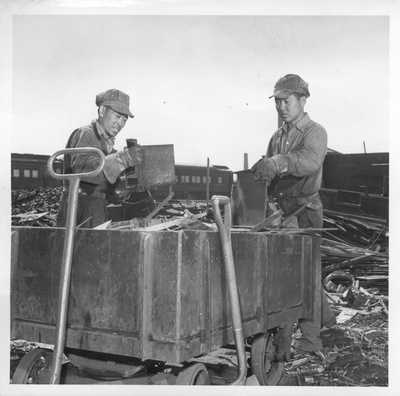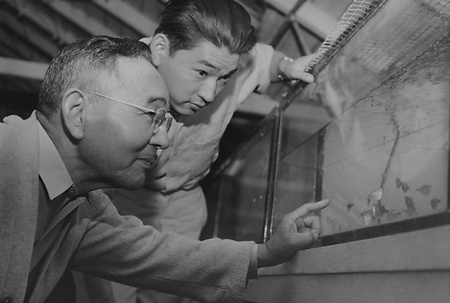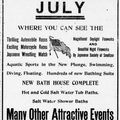One of the 1982 oral histories recalling Wintersburg’s past was conducted with Mr. Clarence Iwao Nishizu (by Professor Emeritus Arthur A. Hansen as part of the Honorable Stephen K. Tamura Orange County Japanese American Oral History Project, jointly sponsored by the Japanese American Council of the Bowers Museum Foundation—Historical and Cultural Foundation of Orange County, and the Japanese American Project of the California State University, Fullerton, Oral History Program).
Clarence Nishizu’s accounts of Wintersburg are remarkably detailed and revealing of his gentle sense of humor. He recalls an incident involving the Asari Goldfish Hatchery, which was located at 8741 Wintersburg Avenue (now Warner Avenue).
Nishizu remembers Tsurumatsu “T.M.” Asari opened a goldfish hatchery in Wintersburg in 1924, after World War I. Asari was a successful farmer, who also farmed acres of sugar beets and alfalfa.
Asari had “…made enough money to purchase forty acres in Wintersburg, where he started farming vegetables. His son Harley has told me that at the time his family moved to Wintersburg, the area was full of tules and open fields.” Asari also opened one of the first Japanese grocery stores in Wintersburg. His son, Harley, worked with him at the Goldfish Hatchery.
Something lively jumping up and down
“I recall an incident that occurred years ago that involved the Asari fish. One evening I was driving on Stanton Boulevard, now Beach Boulevard. About a mile south of Stanton, where there was a bend in the highway, I noticed that many cars had stopped on the road. Soon I could see thousands of something lively jumping up and down on the pavement,” relays Nishizu. “The cars had stopped because nobody wanted to run over the beautiful goldfish strewn all over the road. I stopped my car and went to find out what happened.”
“Apparently Harley Asari was hauling the goldfish on his Dodge pickup truck, whose rear loading space was covered on the top and screened on the side, when he was involved in an accident,” continues Nishizu. “Harley was a young lad then who was conscientiously helping his father, and I felt very sorry that the accident had happened to him. I wanted to pick up the goldfish and retrieve them for him, but the fish were too elusive…”
The Asari Goldfish Hatchery survived more than one upheaval. Huntington Beach historian Jerry Person recalls in in his 2003 Huntington Beach Independent column, Water, water everywhere, that “Harley Asari’s goldfish hatchery lost several thousand valuable goldfish” when the Santa Ana River flooded in 1938.
And then, World War II
There is a photograph in the UC Berkley Bancroft Library collection of Harley Asari—who, like many Wintersburg and Huntington Beach residents of Japanese ancestry—was evacuated to the Poston Arizona Relocation Camp.
The photograph shows him working with another evacuee at a Denver, Colorado foundry for the war effort in 1944. This photograph also was used in a War Relocation Authority publication, New Neighbors Among Us, which reported on the progress of relocated Japanese Americans.

Harley Asari (left) at the Denver, Colorado foundry in 1944 where he found work during World War II. (Photo, War Relocation Authority, University of California Berkeley, Bancroft Library)
After the war
Wintersburg ultimately was annexed into the City of Huntington Beach. The Huntington Beach City Council minutes of March 7, 1960, show a business license approval for the Asari Goldfish Hatchery, Inc., 8741 Wintersburg Avenue, “for the business of Raising Tropical Fish, Goldfish and Distributing Pet Supplies.”
The Japanese American National Museum’s collection includes a photograph of Mr. Asari and son inspecting their fish.

Asari Goldfish Farm, Orange County, California, November 27, 1951. Photograph by Toyo Miyatake Studio, Gift of the Alan Miyatake Family, Japanese American National Museum. (96.267.153)
There were three Japanese goldfish farmers in Wintersburg, including C. M. Furuta, whose farm adjoined the Wintersburg Japanese Presbyterian Mission complex (at Warner Avenue and Nichols Lane), and the goldfish ponds of Henry Kiyomi Akiyama.
Akiyama arrived in Southern California in 1904 at the age of 16 and by the 1920s was raising fish full time, starting first on the Furuta farm. He became C.M. Furuta’s brother-in-law, marrying Yukiko Furuta’s sister, Masuko.
Akiyama’s son, Joseph Akiyama, recalls in an 1989 Los Angeles Times’ article, Koi’s Town: County’s Akiyamas Have Been Raising ‘Living Jewels’ Since the 1920s, seeing his father “oading an old pickup truck with barrels of goldfish and driving up to Los Angeles to sell his swimming rainbows door to door at pet shops.”
The Akiyamas last goldfish hatchery was the Pacific Goldfish Farm on Golden West Street in Westminster. At one time, the Akiyamas owned the West’s largest goldfish farm at the site of the present-day Westminster Mall (off the 405 Freeway, near Golden West Street and Bolsa Avenue).
Goldfish farmer C.M. Furuta arrived in the United States in 1900 and purchased his property in Wintersburg sometime between 1904 and 1909, donating a portion of the land to the Wintersburg Japanese Presbyterian Mission.
The Furuta family left their goldfish ponds in someones’ care when they were evacuated to the Poston Arizona Relocation Center during World War II. By the time they returned, the ponds were filled with silt and were not restored for fish. The Furutas went on to other enterprises, including sweet pea and water lily flower farming. The Furuta farm is the sole remaining Japanese-owned property in Historic Wintersburg.
Read the oral history of Clarence Iwao Nishizu.
*This article was originally published on the Historic Wintersburg blog on February 11, 2012.
© 2012 Mary Adams Urashima






